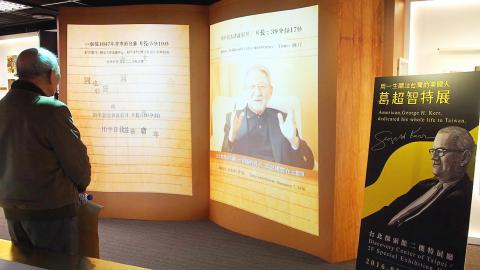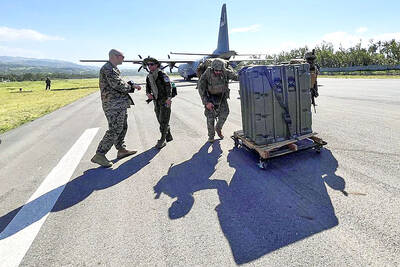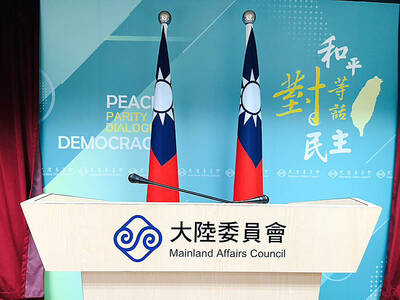A special exhibition on George Kerr — a US diplomat during the 228 Incident, an academic and supporter of Taiwanese democracy — has been organized by the Taipei Department of Information and Tourism to mark this year’s commemoration of the Incident.
The exhibition opened on Wednesday and is scheduled to run until May 22. It focuses on Kerr’s life, his experience of and writings on the 228 Incident and his contribution to democracy in Taiwan, as well as his transformation into a supporter of Taiwanese independence.
The 228 Incident refers to a massacre that begin on Feb. 28, 1947, that was carried out by then-Chinese Nationalist Party (KMT) government troops to quell a popular uprising. The massacre marked the beginning of the White Terror era. The number of people who were killed or went missing remains unknown, but some historians have put the figure in the tens of thousands.

Photo: Tsai Ya-hua, Taipei Times
As a witness, Kerr’s English-language writings about the 228 Incident had a major impact on Taiwan’s historiography of the event, said Chen Yi-shen (陳儀深), an Academia Sinica associate research fellow and a historian.
Chen added that viewing the 228 Incident from the perspective of a US observer is unique to Taiwan’s commemorative events and museum exhibitions on the subject.
Chen said that Kerr was in Taipei when government troops opened fire on civilians gathered before the provincial government compound.
Dining in a nearby venue, Kerr ran to the sound of gunfire and found six people with gunshot wounds lying on the square; after determining that four had died, he took the two wounded to a hospital, a courageous act that was applauded by the crowd at the scene, Chen said.
Kerr was forced to leave Taiwan after the 228 Incident, but remained in contact with pro-independence activists, and the White Terror led him to become a supporter of Taiwanese independence, Chen said.
Although Kerr was not a member of the pan-green camp, he was deeply concerned with the lives, liberty and future of Taiwanese people, for which he should be commemorated, Chen added.
In 1937, Kerr first visited the then-Japanese colony of Taiwan and stayed to teach English classes at the Taihoku First Middle School, Taihoku School of Higher Education and Taihoku College of Commerce, which respectively became the modern-day Taipei Municipal Jianguo High School, National Taiwan University of Education, and the National Taiwan University’s College of Law and College of Management.
During World War II, Kerr served as a US Navy officer and later as an analyst in the US Department of War, specializing in Taiwan.
In 1946, Kerr was made the US vice-consul in Taipei and after ending his service with the US government became an academic, teaching at institutions, such as Stanford University and the University of California, Berkeley.
Perhaps his best-known book about Taiwan is Formosa Betrayed, in which he detailed the 228 Incident and vociferously criticized the then-KMT government.
Kerr died in 1992.
The exhibition on Kerr, held in the Discovery Center of Taipei’s second floor, tells his story with personal and family photographs in seven thematically organized sections, including his early experience in East Asia, his career as an English teacher at Japanese colonial schools in Taiwan and his collection of Taiwanese historical artifacts and documents.
There is a section dedicated to the 228 Incident and a filmed interview with Kerr by Japanese interviewer Chosei Kabira.
The exhibition also revealed a previously unpublished recording of Kerr made in 1989 by a Japanese friend, in which Kerr talked about his experience in Taiwan and thoughts about the nation’s future.
“The special exhibition discusses transitional justice from an uncommon perspective and uses a more commercial and approachable way to convey the story of George Kerr. We hope it will inspire young visitors to re-examine the meaning of fairness and justice,” Department of Information and Tourism Commissioner Chien Yu-yen (簡余晏) said.

Three batches of banana sauce imported from the Philippines were intercepted at the border after they were found to contain the banned industrial dye Orange G, the Food and Drug Administration (FDA) said yesterday. From today through Sept. 2 next year, all seasoning sauces from the Philippines are to be subject to the FDA’s strictest border inspection, meaning 100 percent testing for illegal dyes before entry is allowed, it said in a statement. Orange G is an industrial coloring agent that is not permitted for food use in Taiwan or internationally, said Cheng Wei-chih (鄭維智), head of the FDA’s Northern Center for

LOOKING NORTH: The base would enhance the military’s awareness of activities in the Bashi Channel, which China Coast Guard ships have been frequenting, an expert said The Philippine Navy on Thursday last week inaugurated a forward operating base in the country’s northern most province of Batanes, which at 185km from Taiwan would be strategically important in a military conflict in the Taiwan Strait. The Philippine Daily Inquirer quoted Northern Luzon Command Commander Lieutenant General Fernyl Buca as saying that the base in Mahatao would bolster the country’s northern defenses and response capabilities. The base is also a response to the “irregular presence this month of armed” of China Coast Guard vessels frequenting the Bashi Channel in the Luzon Strait just south of Taiwan, the paper reported, citing a

A total lunar eclipse, an astronomical event often referred to as a “blood moon,” would be visible to sky watchers in Taiwan starting just before midnight on Sunday night, the Taipei Astronomical Museum said. The phenomenon is also called “blood moon” due to the reddish-orange hue it takes on as the Earth passes directly between the sun and the moon, completely blocking direct sunlight from reaching the lunar surface. The only light is refracted by the Earth’s atmosphere, and its red wavelengths are bent toward the moon, illuminating it in a dramatic crimson light. Describing the event as the most important astronomical phenomenon

UNDER PRESSURE: The report cited numerous events that have happened this year to show increased coercion from China, such as military drills and legal threats The Chinese Communist Party (CCP) aims to reinforce its “one China” principle and the idea that Taiwan belongs to the People’s Republic of China by hosting celebratory events this year for the 80th anniversary of the end of World War II, the “retrocession” of Taiwan and the establishment of the UN, the Mainland Affairs Council (MAC) said in its latest report to the Legislative Yuan. Taking advantage of the significant anniversaries, Chinese officials are attempting to assert China’s sovereignty over Taiwan through interviews with international news media and cross-strait exchange events, the report said. Beijing intends to reinforce its “one China” principle